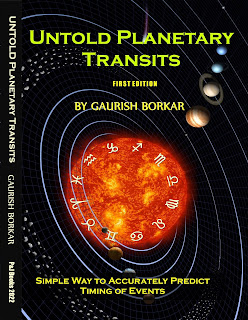Branches Of Indian Astrology
For hundreds and thousands of years
mankind is curious to know how future events will unfold! Man's efforts to know
the outcome of the future has continued unabated from ancient times. Even today
scientists are formulating methods for predicting floods, earthquakes, droughts
etc. But perhaps astrology is the only science which is capable of doing long
term forecast. So let us try to understand what is astrology? The basis of this
science, the different branches of astrology, benefits of studying astrology
and how to study it.
'Jyotish' which means
Astrology in sanskrit is one of the science developed by our ancestors. The
Hindus gave so much importance to Jyotish that they considered it as 'vedanga'
which means, 'limb of vedas'. In India, astrology was and is used so
extensively that it ranges from electing 'good' time for journey, undertaking
new assignments, construction of building, sowing seeds etc. to selecting bride
or bridegroom, seeking astrological advice etc. In fact, during ancient times 'vaidyas'
(Ayurvedic Doctors) used to study the horoscope of the patient before
giving any medical treatment. It is also called as 'Grahachikitsa' or
diagnosis through horoscope.
Branches
of Astrology
Astrology is divided into 3 major parts viz.
(a)Hora -- It is
further divided into Jataka
(Horoscopy), Prashna (Horary
Astrology), Muhurta (Election
Astrology) and Nimitta (Omens)
1. Jataka -- It deals with the
horoscopes of individuals. Events like marriage change in profession, acquiring
property etc. can be predicted with the help of this branch. Most of the
authors try to classify jataka in 3 different schools of thoughts viz.,
i) Parashari --
This is the most widely used system. In this system the karakas or signifying
planets are fixed. For instance Sun is the karaka of father. The planetary
aspects are considered. The methods of planetary strength involves huge
mathematical calculations. There is no doubt about the accuracy of this system.
In our course we are covering this system only.
ii) Jaimini --
This is most difficult system because it is not only explained in 'sutras'
or short aphorisms which are capable of giving different meanings but also
difficult to understand. The other reason which makes the sutras more
difficult to understand is the difference of opinions among various
commentators.
In this system the karakas
are variable. For instance, in one horoscope the karaka of father may be
jupiter while in the other horoscope it
may be some other planet say Moon. This system considers sign aspect rather
than planetary aspect. The method casting
subsidiary charts is totally different from Parashari.
iii) Tajik -- This system is used for
predicting annual results.
1.
Prashna -- It is off shoot of the jataka. The main
difference is that in jataka predictions are made by using the horoscope of
individuals while in prashna an horoscope is cast at the time which an
individual asks a particular question. The question may be related to any
matter like loss of article, theft, acquisition of property, selecting proper
site for digging a well etc.
2. Muhurta -- It deals electing auspicious time for undertaking new
ventures.
3. Nimitta -- It takes into consideration the omen occurring at a
particular time. However there is another school of thought which classifies it
as a part of Samhita.
(b) Sidhanta
or Ganita -- Literally it means mathematics. This
branch refers to Mathematical Astronomy and its use in astrology. It also
includes Gola or spherical astronomy. For instance, calculating the declination
of the planet for its effect on terrestrial activity or considering the apogee
and perigee of planets for its effect on weather.
(c) Samhita
-- It deals with the effects of different planets and its effects on mundane
affairs, formation of clouds, effect of mock sun and mock moon, effect of
comets on mundane affairs, vastu (Construction of palaces and temples.),
etc.






Comments
Post a Comment